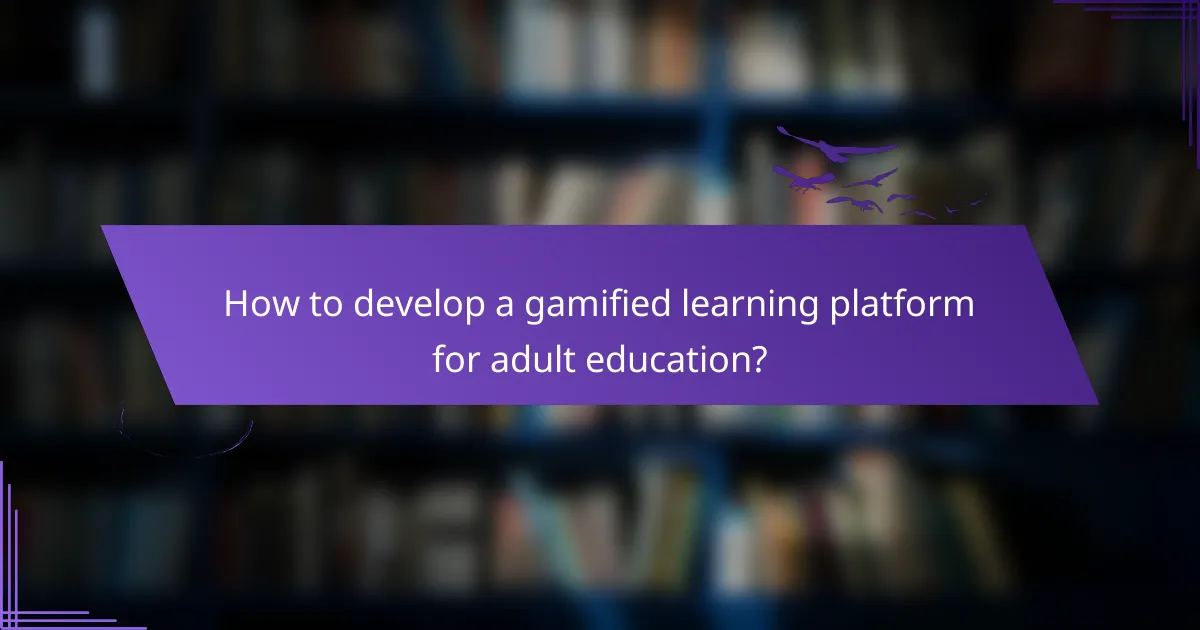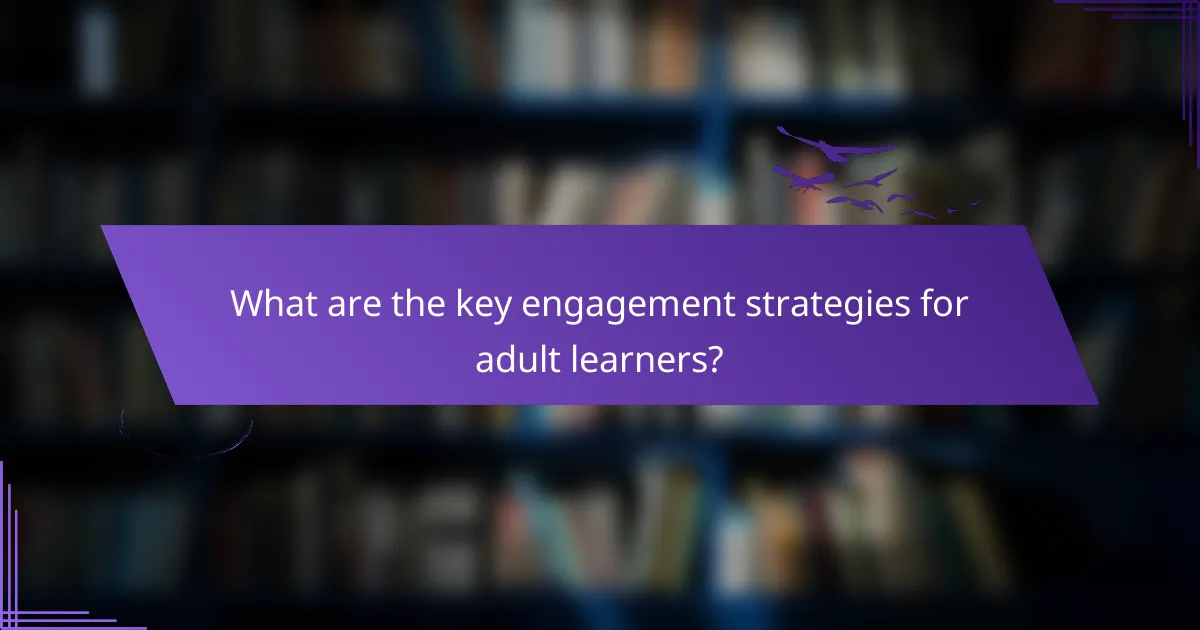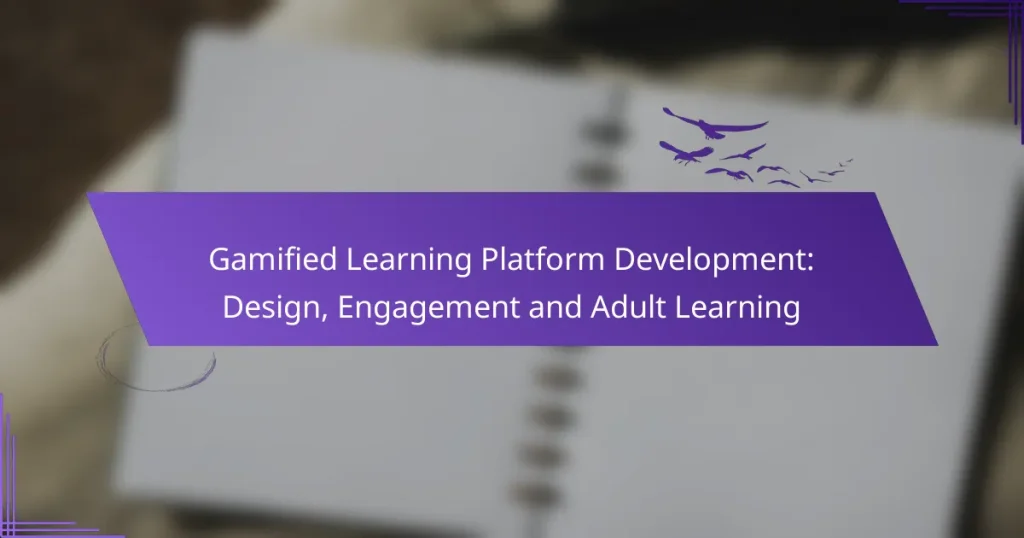Developing a gamified learning platform for adult education requires a strategic focus on engaging game mechanics that inspire motivation and enhance user experience. By incorporating personalized learning paths, social interactions, and reward systems, the platform can effectively cater to the unique needs of adult learners, ultimately improving knowledge retention and application. Additionally, aligning content design with educational goals and integrating assessments can further elevate the impact of the learning experience.

How to develop a gamified learning platform for adult education?
To develop a gamified learning platform for adult education, focus on integrating engaging game mechanics that motivate learners. Prioritize user experience and interactive elements to enhance retention and application of knowledge.
Utilize game design principles
Incorporating game design principles is essential for creating an engaging learning environment. Use elements like points, levels, and badges to reward progress and encourage competition among learners. Consider implementing a narrative or storyline to make the learning journey more immersive.
Balance challenge and skill to maintain engagement; tasks should be neither too easy nor too difficult. This balance can be achieved through adaptive learning paths that adjust based on user performance.
Incorporate interactive elements
Interactive elements are crucial for keeping adult learners engaged. Include quizzes, simulations, and branching scenarios that require active participation. These features not only enhance learning but also allow for immediate application of concepts.
Consider using multimedia resources such as videos and infographics to cater to different learning styles. Incorporating social features, like discussion forums or peer reviews, can also foster collaboration and community among learners.
Focus on user experience
A seamless user experience is vital for the success of a gamified learning platform. Ensure that the interface is intuitive and easy to navigate, minimizing any barriers to entry. Conduct usability testing with real users to identify pain points and improve the design.
Prioritize mobile compatibility, as many adult learners may prefer accessing content on their smartphones or tablets. A responsive design can enhance accessibility and convenience, making learning more flexible.
Leverage technology tools
Utilizing the right technology tools can significantly enhance your gamified learning platform. Consider learning management systems (LMS) that support gamification features, such as Moodle or TalentLMS. These platforms often provide built-in analytics to track learner progress and engagement.
Explore gamification plugins or APIs that can be integrated into existing systems. Tools like Kahoot! or Quizizz can add interactive quizzes and games that boost learner motivation and participation.
Implement feedback mechanisms
Feedback mechanisms are essential for guiding learners and improving their experience. Provide immediate feedback on quizzes and activities to reinforce learning and correct misunderstandings. This can be done through automated responses or personalized messages.
Encourage self-reflection by incorporating features that allow learners to track their progress and set personal goals. Regular feedback can help maintain motivation and ensure that learners stay on track throughout their educational journey.

What are the key engagement strategies for adult learners?
Key engagement strategies for adult learners include personalized learning paths, social learning opportunities, and incentives and rewards systems. These approaches cater to the unique needs and motivations of adults, enhancing their learning experience and retention.
Personalized learning paths
Personalized learning paths allow adult learners to tailor their educational journey according to their individual goals, skills, and preferences. This approach can involve adaptive learning technologies that adjust content based on performance, ensuring that learners focus on areas where they need improvement.
To implement personalized learning paths effectively, consider using assessments to identify learners’ starting points and desired outcomes. Providing options for different learning modalities, such as videos, readings, and interactive activities, can also enhance engagement and accommodate diverse learning styles.
Social learning opportunities
Social learning opportunities leverage collaboration and interaction among learners, fostering a sense of community and shared knowledge. This can include discussion forums, group projects, or peer mentoring, which not only enhance understanding but also build valuable networking skills.
Encouraging participation in social learning can be achieved through structured activities, such as virtual study groups or collaborative tasks. Platforms that facilitate communication, like chat features or video conferencing, can further enhance the social learning experience.
Incentives and rewards systems
Incentives and rewards systems motivate adult learners by recognizing their achievements and encouraging continued participation. This can involve tangible rewards, such as certificates, discounts on future courses, or even monetary bonuses for completing modules or reaching milestones.
To design an effective rewards system, ensure that the incentives align with learners’ goals and preferences. Regularly communicating the benefits of participation and progress can help maintain motivation and engagement throughout the learning process.

What are the best practices for designing gamified content?
Effective gamified content design hinges on aligning with educational goals, incorporating engaging narratives, and integrating assessments. These practices enhance learner motivation and retention, making the educational experience more impactful.
Align with learning objectives
To create gamified content that resonates, it is crucial to align activities with specific learning objectives. This ensures that every game element serves a purpose in achieving educational outcomes, rather than merely entertaining.
Begin by clearly defining the learning goals and then map game mechanics to these objectives. For instance, if the objective is to improve problem-solving skills, design challenges that require critical thinking and decision-making.
Regularly review and adjust the gamified elements to maintain alignment with the learning objectives as the course progresses. This iterative process helps keep the content relevant and effective.
Use storytelling techniques
Incorporating storytelling techniques can significantly enhance engagement in gamified learning. A compelling narrative creates an emotional connection, making the content more relatable and memorable.
Consider using characters, plots, and settings that resonate with adult learners. For example, a scenario where learners must solve a mystery related to their field can motivate them to engage deeply with the material.
Utilize branching narratives that allow learners to make choices affecting the story’s outcome. This not only increases engagement but also encourages learners to explore different perspectives and solutions.
Integrate assessments
Integrating assessments within gamified content is essential for measuring learner progress and understanding. Assessments should be seamlessly woven into the gameplay to provide immediate feedback and reinforce learning.
Use a variety of assessment types, such as quizzes, simulations, or peer evaluations, to cater to different learning styles. For example, a quiz at the end of a game level can help reinforce key concepts while maintaining the fun aspect.
Ensure that assessments are constructive and provide actionable feedback. This helps learners identify areas for improvement and encourages them to continue engaging with the content.

What platforms support gamified learning development?
Several platforms facilitate the development of gamified learning experiences, each offering unique features and capabilities. Popular options include Moodle, Articulate 360, and Adobe Captivate, which cater to different needs in the realm of adult learning.
Moodle
Moodle is an open-source learning management system (LMS) that supports gamified learning through various plugins and features. It allows educators to create engaging courses with elements like badges, leaderboards, and interactive quizzes that motivate learners.
To effectively utilize Moodle for gamification, consider integrating plugins such as Level Up! for tracking progress and awarding points. This approach can enhance learner engagement and foster a competitive spirit among participants.
Articulate 360
Articulate 360 is a comprehensive suite of tools designed for creating interactive e-learning content, including gamified elements. With features like Storyline and Rise, users can develop scenarios that incorporate branching paths, quizzes, and rewards, making learning more immersive.
When using Articulate 360, focus on creating visually appealing and user-friendly interfaces. Utilize templates that support gamification to streamline the design process and ensure a consistent experience across courses.
Adobe Captivate
Adobe Captivate is a powerful authoring tool that enables the creation of responsive e-learning content with gamification features. It supports interactive elements such as simulations, quizzes, and drag-and-drop activities that enhance learner engagement.
To maximize the effectiveness of Adobe Captivate, leverage its built-in templates and themes tailored for gamified learning. Additionally, consider incorporating analytics to track learner progress and adapt content based on performance, ensuring a personalized learning experience.

What metrics should be used to measure engagement?
To effectively measure engagement in a gamified learning platform, consider metrics such as user participation rates, completion rates, and time spent on tasks. These indicators provide insight into how actively users are interacting with the content and their overall commitment to the learning process.
User Participation Rates
User participation rates reflect the percentage of users actively engaging with the platform over a specific period. High participation rates indicate that users find the content appealing and relevant. Tracking this metric can help identify trends and inform content adjustments to enhance user interest.
Completion Rates
Completion rates measure the proportion of users who finish a course or module compared to those who started it. A low completion rate may signal that the content is too challenging or not engaging enough. Aim for completion rates above 70% to ensure that users are deriving value from the learning experience.
Time Spent on Tasks
Time spent on tasks indicates how long users engage with specific activities or lessons. This metric can reveal whether users are struggling with content or fully immersed in it. Ideally, users should spend a balanced amount of time on tasks—enough to absorb information without losing interest. Monitor this metric to adjust pacing and content complexity accordingly.


